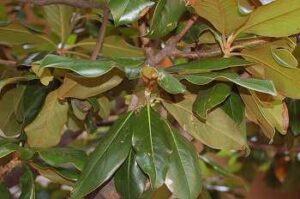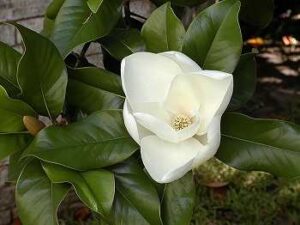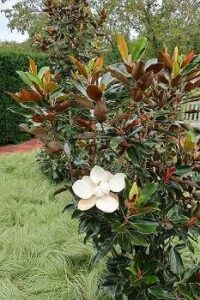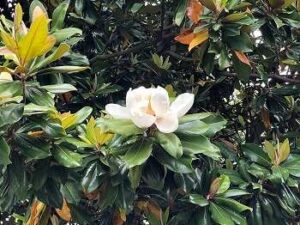The Southern magnolia (Magnolia grandiflora) is a popular choice for adding beauty and grace to your scenery. It is a beautiful tree with big, shiny, green leaves and sweet white flowers. Before planting a Southern magnolia, however, many homes worry about the messiness it might cause. In this piece, we’ll talk about how messy Southern magnolia trees can be and give you ideas and tips to help you make a smart choice for your yard.
How messy are Southern magnolia trees?
Southern magnolia trees have a reputation for being messy due to their continuous shedding of leaves and seed pods throughout the year. While people appreciate the dark green, shiny leaves and large, fragrant flowers of Southern magnolia trees, the continuous dropping of leaves and pods can lead to a messy situation, especially when the tree is placed in a yard.
The messiness of the tree increases due to the annual shedding of old leaves in spring and the release of seed pods in late summer. Southern magnolia leaves have a coarse texture and decompose slowly, posing challenges for cleaning. Consequently, leaves tend to accumulate, creating an untidy appearance in the surrounding area.
Moreover, the substantial size of Southern magnolia trees amplifies their messiness. Certain varieties, including the Southern magnolia, can grow to be exceptionally large, making them unsuitable for small yards. It is important to acknowledge the sheer magnitude of these trees.
Another notable aspect of the Southern magnolia is the fragrance emitted by its blossoms, which contributes to its uniqueness. The tree produces sizable creamy-white flowers, measuring up to 12 inches across, making them among the largest flowers found on any native North American tree. People often describe the scent of these flowers as reminiscent of lemons or citrus, lending a pleasant aroma to the surroundings. However, it is crucial to handle the flowers with care as they can quickly change color if disturbed.
The flowers of the Southern Magnolia grow at the end of thick, tough stems that grow all over the tree. This makes it look like the tree is full of flowers. The flowers usually bloom from late spring to early summer, giving the scenery a splash of color and life during this time.

Factors Contributing to Messiness
1. Leaf Drop Throughout the Year
Southern magnolias lose their leaves at different times of the year, not just in the fall like deciduous trees. This constant leaf drop can make the tree look a bit messy. Regular cleaning is necessary to maintain the scenic beauty as the leaves tend to accumulate on the ground.
2. Seed Pods and Their Disposal
As we’ve already talked about, Southern magnolias have seed pods. When they fall to the ground, these pods, which can be quite big, can add to the messiness of the tree. Depending on how big the tree is and how many seed pods it makes, picking up the seed pods that have fallen can become a daily job.

3. Flower Petal Drop
Southern magnolias have beautiful, sweet white flowers, but they also have a bad side. When the flowers have finished blooming, the petals start to fall off and make a white bed on the ground. This can be nice to look at, but it needs to be cleaned up to keep the scenery looking nice.
4. Coarse Leaves and Debris
The big, rough leaves of Southern magnolias can be harder to clean up than the small, soft leaves of other plants. Because of their size and thickness, they are harder to break down, so they stay on the ground longer. Then there’s the fact that the leaves and branches of the tree aren’t the only thing that can be used to make a mess.
Managing the Messiness of Southern Magnolia Trees

While Southern magnolia trees do have some inherent messiness, there are strategies you can employ to manage and minimize the impact. Here are some tips:
1. Regular Maintenance and Cleanup
The best way to deal with the messiness of Southern magnolia trees is to keep up with regular care. Here are some things you can add to your daily schedule:
- Raking Leaves: Rake and remove fallen leaves often to keep your yard looking neat. Consider using a leaf fan or a mulching mower to speed up the cleaning process.
- Seed Pods: When the seed pods fall off the tree, pick them up and throw them away in the right way. You can use a rake or just your hands to pick them up. If you have a garbage pile, you should consider putting some seeds to it.
- Flower Petal Removal: As the flower petals fall, you can pick them up with a leaf brush or a light sweep of a mop. This will help your yard look clean and well taken care of.
2. Strategic Placement
To reduce the effect of its messiness, consider where to plant your Southern magnolia tree. Here are some things to think about:
- Lawn Area: If you plant a Southern magnolia tree right in your lawn, you may have to clean up leaves and other trash more often. Planting the tree away from green places is a good idea if you want a clean yard.
- Mulched Beds: If you plant the tree in a mulched bed or put a layer of mulch around its base, it will help keep leaves and other garbage from blowing away. Mulch acts as a natural barrier, making it easier to clean up and stopping the trash from moving to other places.
3. Professional Tree Care
You can keep the health and look of your Southern magnolia tree while reducing messiness by hiring the services of a professional landscaper or tree care company. They can prune the tree to get rid of dead or broken branches, which can cut down on the amount of trash that falls from the tree. A professional can also give advice on how to take care of trees in the best way possible to keep them healthy and avoid messiness.
Some examples of messy trees that should be avoided in landscaping

When it comes to landscaping, choosing the right trees is essential to create a clean and low-maintenance outdoor space. Some trees are known to be messy because they drop leaves, flowers, fruit, or other things. This can make the lazy gardener have to do more work. Here are some examples of messy trees that you should not plant in your yard:
- Catalpa: The catalpa tree is known for dropping flowers, leaves, and other things. It has big, heart-shaped leaves that can make a lot of mess in the area.
- Sweet Gum: Another tree that drops leaves and other things is the sweet gum tree. Its “gumballs,” which are spiky seed balls, can be dangerous and need to be cleaned up often.
- Pecan: Nuts from pecan trees are known to be tasty, but they can also be messy. The tree loses its leaves and nuts in the fall, which can be a lot of work.
- Oak: Oak trees are beautiful and grand, but they drop leaves, nuts, and other things. Large leaves and acorns can cover the ground, which needs to be cleaned regularly.
- Sycamore: Sycamore trees have big, beautiful leaves that turn yellow and brown before falling off. This can make the place look messy, especially during the fall.
What are the pros and cons of Southern magnolias?
Let’s talk about the good and bad things about Southern magnolias.
Pros:
- Aesthetic Value: One of the main benefits of Southern magnolias is their aesthetic value. They have beautiful white flowers that can grow up to 12 inches across. Not only are the flowers pretty to look at, but they also have a rich, sweet smell that adds to their overall charm. The dark, shiny evergreen leaves of the tree make a nice background all year long.
- Adaptability: Southern magnolias are known for being able to grow in many different kinds of soil. They can grow in both sun and shade and can handle changes in how much water is in the soil. They can even grow in clay soil, which makes them a good choice for many different types of land.
- Drought tolerance: Southern magnolias do well in dry conditions once they are well-established. This means they can survive when there isn’t much water, which makes them good for places where there isn’t always enough water.
- Southern magnolias are generally resistant to pests and diseases. They don’t have many big bug problems, so they don’t need pesticides and upkeep as often.
- Evergreen: Unlike trees that lose their leaves in the fall, Southern magnolias keep their leaves all year long. Even in the winter, this adds a bit of green to the scenery and makes it more interesting to look at.
Cons:
- Slow to Flower: One of the problems with Southern magnolias is that it can take them a long time to grow up and start blooming. Unnamed plants typically don’t bloom for about 10 years after planting, so the grower needs to be patient.
- The term “messy” is used to describe the way that a person’s behavior toward a given situation. Throughout the year, they drop leaves and other things that need to be cleaned up and maintained to keep the area clean.
- Size and Space Needs: Southern magnolias can reach heights of 60 to 80 feet and spread out over a wide area as they grow. This means they need a lot of room to grow to their full size and spread out roots. If you put them too close to buildings or other plants, they might get too close and fight with each other.
- Soil: Southern magnolias can grow in a variety of soils, but they do best in slightly acidic to neutral soils that are moist but drain well. If the soil is too alkaline or too hard, it may not be good for their health, and they may need soil amendments or more care to make it better.
Southern Magnolia Tree Facts
- One thing that makes Southern Magnolia trees stand out is that they have a lot of evergreen leaves that are smooth and rubbery. The leaves are in pairs and are 5 to 10 inches long. The top side is shiny and dark green, and the bottom side is rusty brown. This leaf color makes a nice difference and gives the tree more visual interest.
- Another interesting thing about the Southern Magnolia is that it has beautiful flowers. They are big, creamy white, and have a pleasant smell. The flowers grow at the end of thick, tough stems that grow all over the tree. But it’s important to remember that the flowers can change color quickly if they get hurt.
- Southern Magnolia trees are slow to medium growers when it comes to how fast they get bigger. They can grow about 12 to 24 inches (31 to 61 cm) per year, on average. This fairly slow growth rate gives the tree time to build up a strong and sturdy structure.
- In the southern states of Louisiana and Mississippi, the Southern Magnolia has a lot of traditional and symbolic value. It is the state flower of both Mississippi and Louisiana, which makes it a popular and well-known tree in these states. Because of its connection to these states, the tree is known and liked for more than just how it looks.
How can I successfully grow Southern Magnolias?
Southern magnolias, also called Magnolia grandiflora, are beautiful trees that can add grace and flavor to any setting. Here are some rules to follow if you want to grow these trees successfully:
- Site Selection: Choose a good spot for your Southern magnolia as a first step. The sun is better for these trees than light shade. Choose a spot where the plant will have enough room to grow and develop its beautiful leaves.
- Soil: Southern magnolias thrive in acidic, moist, and well-drained soils. To prevent root rot, it is crucial to ensure proper drainage and avoid excessive moisture. If your soil is heavy or clay-like, enhancing it with compost or peat moss can improve its drainage capabilities.
- When it comes to planting Southern magnolias, starting with a strong impact is advisable. By planting during favorable seasons, the tree has ample time to establish its root system before potentially facing adverse weather conditions.
- Digging the Hole: Dig a hole that is bigger and deeper than the root ball of the tree. This will help the plant’s roots grow outward. Avoid planting the tree too deep, as this could cause the roots to become suffocated. The top of the root ball should be at or just above the surface of the soil.
- Watering: After planting the tree, give it a lot of water to get the earth to settle and get rid of any air holes around the roots. During the first year, water the plant regularly to make sure it gets a good start. Southern magnolias like moist earth, but they can also handle changes between wet and dry.
- Mulching: Put a layer of organic soil around the base of the tree. This could be wood chips or bark. Mulching helps keep the soil wet, stops weeds from growing, and keeps the soil at the right temperature. To keep the tree from dying, keep the dirt a few inches away from the root.
Characteristics of Southern Magnolia
The Southern Magnolia, scientifically known as Magnolia grandiflora, is a stunning tree renowned for its distinctive characteristics. With its dense growth of glossy evergreen leaves, fragrant creamy-white flowers, and towering stature, the Southern Magnolia truly enhances any landscape.
Reaching heights of up to 50 feet, and occasionally even 100 feet, this magnificent tree commands attention in gardens, parks, and farms alike. Its tall, conical shape and expansive canopy make it a prominent presence, providing ample shade and serving as a captivating focal point in outdoor spaces.
The leaves of the Southern Magnolia are one of the things that make it stand out. The leaves are alternate, which means that they grow in pairs on each tree. They are usually between 5 and 10 inches long and have a glossy, shiny green top that makes the tree look a little bit more beautiful. The undersides of the leaves are red or brownish, which is a nice contrast. The leaves are also thick and evergreen, which means they stay on the tree all year, giving it beauty and protection all year long.
Conclusion
Southern magnolia trees are beautiful and can make any setting look more elegant. But it’s important to think about the messiness that these trees could cause. Even though they lose leaves, produce seed pods, and drop flower petals all year long, regular maintenance, smart placement, and professional tree care can help you control the messiness. By considering these factors and making informed decisions, you can revel in the beauty of Southern magnolia trees without becoming overwhelmed by the cleanup.
Read Next: Magnolia flower Meaning And Symbolism
